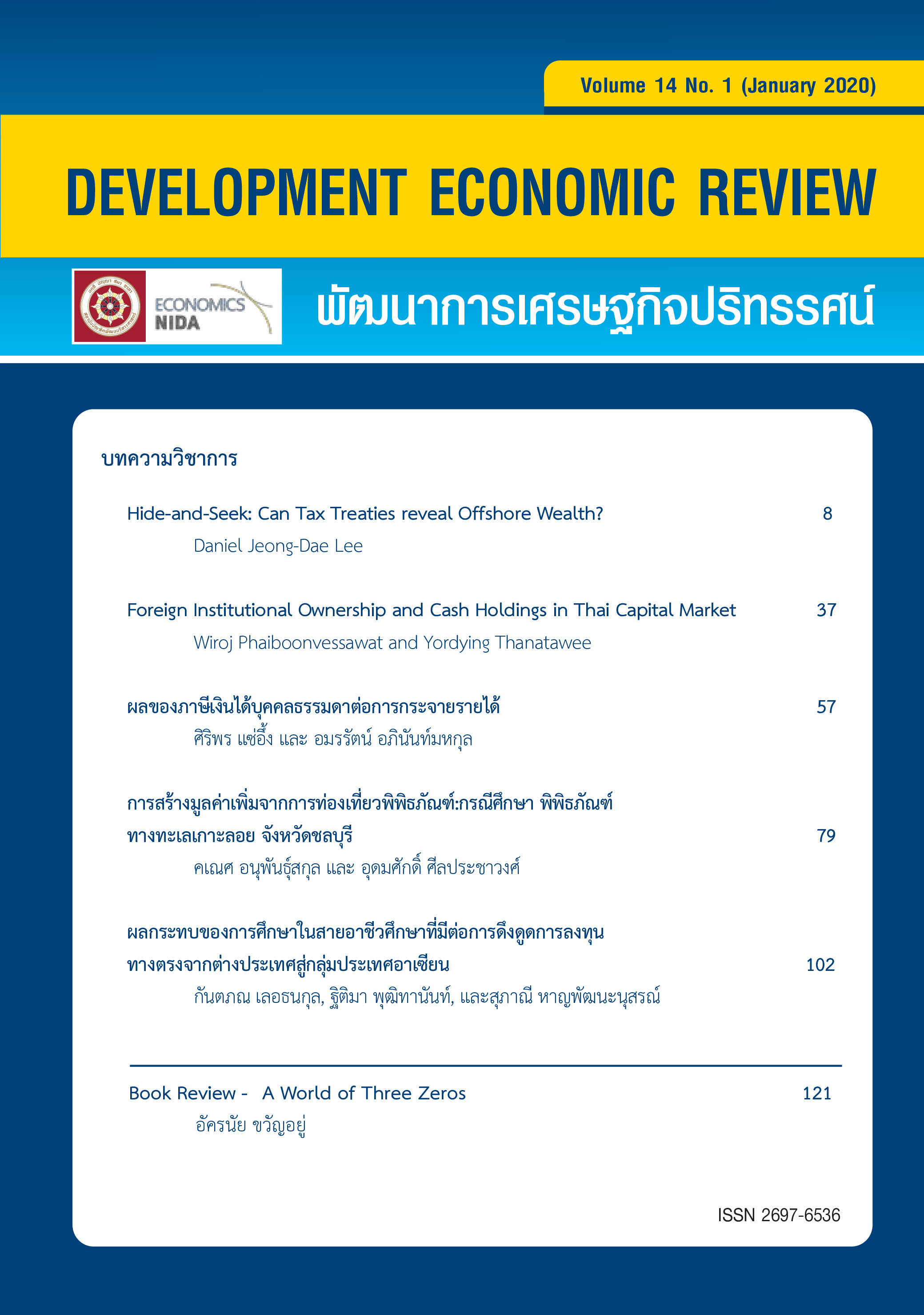Impact of Vocational Education on Attracting Foreign Direct Investment to ASEAN Countries
Keywords:
Vocational Education, Foreign Direct Investment, ASEANAbstract
This study aims to examine whether the vocational education system in ASEAN should help attracting foreign direct investment into the region. Using secondary data in ASEAN since 1994 - 2015 with the random effect equation, our results show that the number of vocational students affects direct foreign direct investment to Thailand, Indonesia, the Philippines and Malaysia, but does not affect the direct investment from Singapore, Brunei, Laos PDR and Cambodia. Therefore, one of strategies to promote foreign direct investment into this ASEAN region, the ASEAN member countries should have agreement to improve quality and establish the standard of vocational education in this region.
References
Aring, M. (2015). ASEAN Economic Community 2015 : Enchancing Competitiveness and Employability Through Skill Development. Bangkok: International Labour Organization. Retrieved from https://www.ilo.org/wcmsp5/groups/public/---asia/---ro-bangkok/documents/publication/wcms_344796.pdf.
Demirhan, E., & Masca, M. (2008). Determinants of foreign direct investment flows to developing countries: A cross-sectional analysis. Prague Economic, 2008(4), 356-369.
Du, J. (2011). What are the Determinants of FDI to Vietnam. Tilburg: Tilburg University. Retrieved from http://arno.uvt.nl/show.cgi?fid=114526.
Dunning, J. H., & Narula, R. (1993, September). Transpacific Foreign Direct Investment And The Investment Development Path: The Record Assessed. Maastrcht: Faculty of Economics, International Business Section, University of Limburg, 93(24). Retrieved from https://www.merit.unu.edu/publications/rmpdf/1993/rm1993-024.pdf.
Gocer, I., Akin, T., & Alatas, S. (2016). The effects of saving-investment gap on economic growth in developing countries : A clustering and panel data analysis. Theoretical and Applied Economics, 23(2), 157-172.
João Pedro Gomes de Oliveira. (2014). The Determinants Of Foreign Direct Investment In Bric Countries: A Focus On Brazil. Porto: Catholic University of Portugal. Retrieved from
https://repositorio.ucp.pt/bitstream/10400.14/16882/1/Master%20Dissertation_Jo%C3%A3o%20Pedro%20Oliveira.pdf
Lucas, R. E. (1990). Why Doesn't Capital Flow from Rich to Poor Countries? The American Economic Review, 80(2), 92-96.
Mankiw, N. (2009). Macroeconomics. New York: Worth Publishers.
Nair, D. (2016). Learning Diplomacy: Cambodia, Laos, Myanmar and Vietnam Diplomats in ASEAN. Singapore: ISEAS Publishing.
Newman, C., Rand, J., Talbot, T., & Tarp, F. (2015). Technology transfers, foreign investment and productivity spillovers. European Economic Review, 76, 168–187.
Noorbakhsh, Farhad; Paloni, Alberto. (2001). Human capital and FDI inflows to developing countries: New empirical evidence. World Development, 29, 1593-1610.
Open Data of Singapore. Retrieved from https://data.gov.sg/group/education. (December 3, 2017).
Organization International Labour. (2014). Survey of ASEAN Employers on Skills and Competitiveness / Emerging Markets Consulting (Vol. 1). Bangkok. Retrieved from
https://www.ilo.org/wcmsp5/groups/public/---asia/---ro-bangkok/---sro-bangkok/documents/publication/wcms_249982.pdf.
Park, C., & Mercado, R. (2011). What Drives Different Types of Capital Flows and Their Volatilities in Developing Asia. ADB Working Paper Series on Regional Economic Integration No.84. Retrieved from
https://www.adb.org/sites/default/files/publication/29154/wp84-mercado-park-types-volatilities-capital-flows-0.pdf.
Park, D., & Shin, K. (2009). Saving, Investment, and Current Account Surplus in Developing Asia. ADB Economics Working Paper Series No.158. Manila: Asian Development Bank. Retrieved from https://www.adb.org/sites/default/files/publication/28249/economics-wp158.pdf
Protsenko, A. (2004). Vertical and Horizontal Foreign Direct Investments in Transition Countries. München: Ludwig-Maximilians-University. Retrieved from
https://edoc.ub.uni-muenchen.de/2105/1/Protsenko_Alexander.pdf.
Salike, N. (2016). Role of human capital on regional distribution of FDI in China:New evidences. China Economic Review, 37, 66-84.
Solow, R. M. (1956). A contribution to the theory of economic growth. Quarterly Journal of Economics, 70(1), 65-94.
Technical Education and Skills Development Authority. Retrieved from
https://www.tesda.gov.ph/Uploads/File/Planning2015/TVETSTAT/Philippine-TVET-Statistics2008-2013-%20FINAL.pdf. (December 3, 2017).
The World Bank. Retrieved from https://data.worldbank.org/. (December 3, 2017).
UNICEF. UNICEF. Retrieved from https://data.unicef.org/. (December 3, 2017).
บุษกร วัฒนบุตร. (2559). การพัฒนาศักยภาพทุนมนุษย์ในศตวรรษที่ 21. ธรรมทรรศน์, 163-176.
Vatthanabut B. (2016). Human capital potential development in 21st century. Dhammathas Academic Journal, 16(2), 163 – 176. (In Thai)
Downloads
Published
Issue
Section
License
Copyright to published manuscripts becomes the property of the Graduate School of Development Economics, National Institute of Development Administration. Reproduction of all or part of a Development Economic Review (DER) article by anyone, excluding author(s), is prohibited, unless receiving our permission.
Disclaimer: Opinions expressed in articles published in this journal are those of the author (s) and do nto necessarily represent opinions of the Graduate School of Development Economics, National Institute of Development Administration. Trade and proprietary names are only for identification and not constitute our endorsement.


